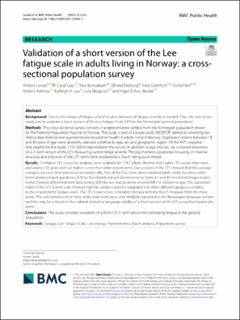| dc.contributor.author | Lerdal, Anners | |
| dc.contributor.author | Gay, Caryl | |
| dc.contributor.author | Bonsaksen, Tore | |
| dc.contributor.author | Ekeberg, Øivind | |
| dc.contributor.author | Grimholt, Tine Kristin | |
| dc.contributor.author | Heir, Trond | |
| dc.contributor.author | Kottorp, Anders | |
| dc.contributor.author | Lee, Kathryn A. | |
| dc.contributor.author | Skogstad, Laila | |
| dc.contributor.author | Schou-Bredal, Inger | |
| dc.date.accessioned | 2024-02-09T08:52:52Z | |
| dc.date.available | 2024-02-09T08:52:52Z | |
| dc.date.created | 2023-10-31T10:54:23Z | |
| dc.date.issued | 2023 | |
| dc.identifier.citation | BMC Public Health. 2023, 23 (2132), . | en_US |
| dc.identifier.issn | 1471-2458 | |
| dc.identifier.uri | https://hdl.handle.net/11250/3116530 | |
| dc.description.abstract | Background Due to the nature of fatigue, a brief reliable measure of fatigue severity is needed. Thus, the aim of our study was to evaluate a short version of the Lee Fatigue Scale (LFS) in the Norwegian general population. Methods This cross-sectional survey consists of a representative sample from the Norwegian population drawn by The National Population Register in Norway. The study is part of a larger study (NORPOP) aimed at collecting normative data from several questionnaires focused on health in adults living in Norway. Registered citizens between 18 and 94 years of age were randomly selected stratified by age, sex and geographic region. Of the 4971 respondents eligible for the study, 1792 (36%) responded to the survey. In addition to age and sex, we collected responses on a 5-item version of the LFS measuring current fatige severity. The psychometric properties focusing on internal structure and precision of the LFS items were analyzed by a Rasch rating scale model. Results Complete LFS scores for analyses were available for 1767 adults. Women had higher LFS-scores than men, and adults < 55 years old had higher scores than older respondents. Our analysis of the LFS showed that the average category on each item advanced monotonically. Two of the five items demonstrated misfit, while the three other items demonstrated goodness-of-fit to the model and uni-dimensionality. Items #1 and #4 (tired and fatigue respectively) showed differential item functioning (DIF) by sex, but no items showed DIFs in relation to age. The separation index of the LFS 3-item scale showed that the sample could be separated into three different groups according to the respondents’ fatigue levels. The LFS-3 raw scores correlated strongly with the Rasch measure from the three items. The core dimensions in these individual items were very similarly expressed in the Norwegian language version and this may be a threat to the cultural-related or language validity of a short version of the LFS using these particular items. Conclusions The study provides validation of a short LFS 3-item version for estimating fatigue in the general population. | en_US |
| dc.language.iso | eng | en_US |
| dc.rights | Navngivelse 4.0 Internasjonal | * |
| dc.rights.uri | http://creativecommons.org/licenses/by/4.0/deed.no | * |
| dc.title | Validation of a short version of the Lee fatigue scale in adults living in Norway: a cross-sectional population survey | en_US |
| dc.title.alternative | Validation of a short version of the Lee fatigue scale in adults living in Norway: a cross-sectional population survey | en_US |
| dc.type | Peer reviewed | en_US |
| dc.type | Journal article | en_US |
| dc.description.version | publishedVersion | en_US |
| dc.source.pagenumber | 9 | en_US |
| dc.source.volume | 23 | en_US |
| dc.source.journal | BMC Public Health | en_US |
| dc.source.issue | 2132 | en_US |
| dc.identifier.doi | 10.1186/s12889-023-17036-1 | |
| dc.identifier.cristin | 2190392 | |
| cristin.ispublished | true | |
| cristin.fulltext | original | |
| cristin.qualitycode | 1 | |

